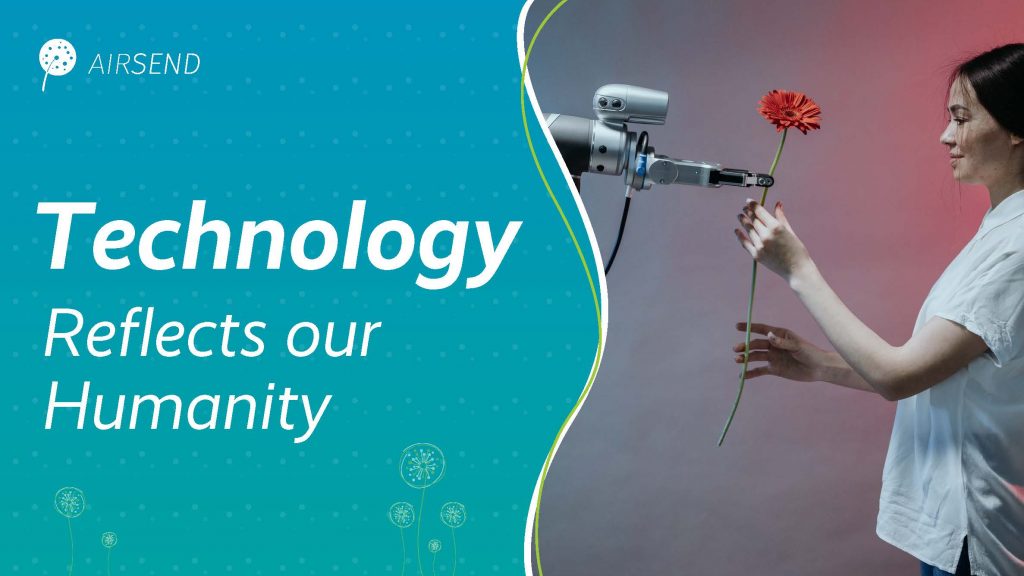
Technology influences and informs the ways we express our identity and engage with others.
Interests Feed Identities, Which Grow Communities
A fascinating aspect of modern-day society is how we develop our interests and how these interests become a shorthand code for our identities. As people have more time and resources to flourish instead of being consumed by the plight of survival, our interests and identities are becoming increasingly complex, as we understand more about ourselves and each other.
A related point is how we associate with others based on our interests and identity affiliations [1]. Even in a professional environment, we tend to cluster with others who share our interests or who align with our identities. We create networks of connections based on the mutual understanding of shared or complementary interests and traits.
Technology has enabled us to widely publish our identities and provided new avenues of interaction within our communities. It has also changed how we synthesize and organize the never-ending stream of information and content, which further feeds and reinforces all these different interests. The way in which we process and assimilate content into our identities influences the connections we make within our social groups. In short, different people assemble information in different ways [2], and that affects who we connect with.

How We Connect
The method or manner of connection is almost as important as the content over which we connect. As our content evolves, so too do the platforms where we consume content and engage with one another. These platforms are becoming ever more digital; meeting someone new is as likely to happen online as it is to happen in a workplace, campus, or social meetup [3].
Communication and organization technology has come a long way, even in the past few years. Now we have incredibly sophisticated messaging and social media apps, integrative Kanban boards, collaborative calendars, endless online forums, and resource blogs. We have transitioned our physical tools and meeting spaces into a digital landscape, and we heavily rely on this landscape to support more and more of our daily functions.
The Digital Impact
Yet the convenience of life online has also resulted in digital experiences taking bigger and bigger bites out of our days. We have begun to notice the influence of digital platforms on our expressions of identity, as in the Sapir–Whorf hypothesis. This linguistics theory (also called Linguistic Relativity) suggests that the structure of our language shapes not only what we think, but how we think it. Which, in turn, influences how we perceive the world [4].
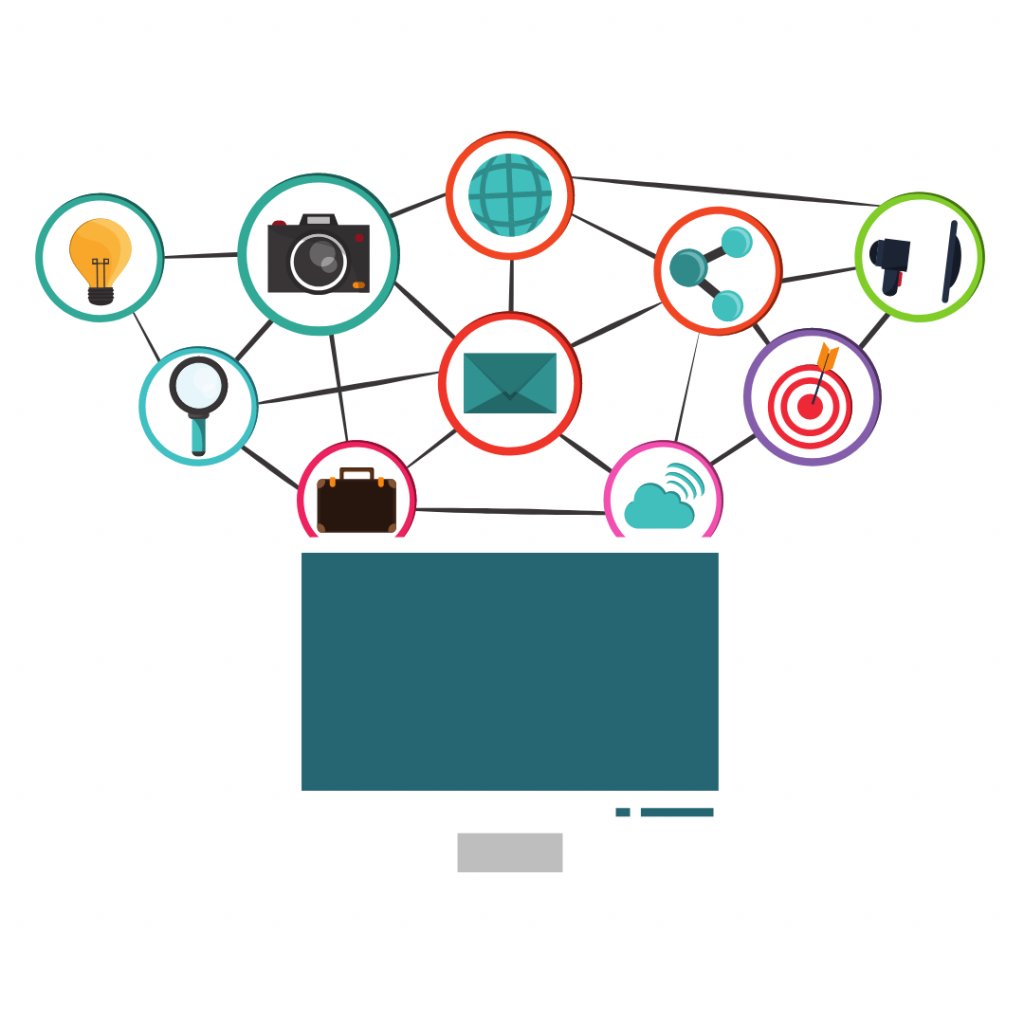
These technological conveniences have become life-altering tools, especially for marginalized groups whose access to resources has been historically curtailed. People can look up information, search for resources, learn more about their and other communities, develop new ways to play, work, and create, and find new methods to improve their quality of life.
This last point will be particularly significant as the global population continues to age; studies show that currently, over 1 billion people rely on assistive technology [5]. That market is projected to grow to nearly $8 billion between 2021 and 2025, with an extra boost from the COVID-19 pandemic [6].
The Tools that Shape Us
With that conceptual underpinning out of the way, let’s explore how we can use these tools to explore our interests, profess our identities, and assemble meaningful social groups without becoming lost in the blue light of our screens.
It comes down to the quality of the tool. The more streamlined and intuitive a tool is, the more we lose sight of the platform itself. With a smooth enough interface, a tool can become an extension of our own minds and bodies.
When we want to talk to a family member or friend, we don’t have to trace out all the steps involved in opening an app and typing the message. Our brains carry out these support tasks almost without thinking because we trained ourselves to use these devices. We spend our energy, instead, on the heart of communication – composition.
What am I going to say, and how am I going to say it?
Investing in User Experience
Companies designing our hardware and software technologies have invested in the “User Experience.” After all, the easier it is to use something, the more likely we are to do so. That means more money for the company, through paid services or advertising revenue.

One of the main strategies to reduce our awareness of technology is to have that tool become ubiquitous. We don’t notice something if it’s everywhere we look. Furthermore, we have positive reactions to tools when they spring to our fingertips to fulfill a need or task. All the better if these tools slip back under the surface of our awareness once we’re done with it. No mess, no fuss.
This is one reason why Google has developed its own digital toolkit through Google Workspace, which aims to supplant the familiar Microsoft applications. It has also pursued integrations with nearly every interface, adapting to the mobile lifestyles of its users [7].
Microsoft is also trying to expand its empire by building into cloud computing and AI, taking advantage of the computers, large and small, all around us [8]. By immersing us in “tech intensity”, the company aspires “to empower every person and every organization on the planet to achieve more” [9].
The focus of these industry giants emphasizes the importance of application integrations. Businesses that provide these nimble responses to clients and consumers preserve profits and grow in the market.
A survey run by Cleo found that failure to support modern integrations leads to “annual revenue losses of $250,000 to $500,000 for 57 percent of those surveyed and upward of $1,000,000 for others” [10]. Similarly, the Forbes Technology Council cites “Near Perfect Digital Experience” as number five in their list of critical trends expected to dominate the software development industry. “Progressive Web Apps” and “User Experience Design” were also listed [11].
The Pandemic Effect

The COVID-19 pandemic painfully highlighted all the lackluster avenues of technology that failed to advance with the general tide. Even though we had access to communication and collaboration technologies, they weren’t enough to keep up with our need for such tools when we could no longer safely gather in person.
As companies adapted and new software tools were churned out, our reliance on technology increased. For those of us working from home (about 42% of the U.S. workforce, according to this analysis [12]), our professional and personal lives were almost entirely translated into the digital landscape.
Voice-over-Internet-Protocols (VoIP) or videoconferencing are both prime examples of an avenue of sluggish advancement that exponentially improved in response to the pandemic. At first, the technological capability to call anyone in the world and chat over video – so long as you both had accounts and a solid internet connection – was revolutionary. Skype dominated this niche for years, with modest upgrades and improvements, particularly with Microsoft’s acquisition in 2011 [13].

Mostly though, this technology was implemented by consumers rather than businesses. Professionals preferred to meet in person or use phone conferencing to collaborate as these were the more stable options. When video conferencing was attempted, Skype For Business or Cisco’s WebEx filled the need.
In practice, these solutions could be difficult to implement, with unreliable performance. Yet there was no major push to innovate from the business market or from within the technology companies. They had other fish to fry, which promised greater returns on profit or tech development.
Advancing Technology
The pandemic forced huge populations of the workforce to work via remote connections and improvised desks at home. Meetings still had to happen though, and video and audio quality were no longer negotiable.
We can tolerate some degree of robot voice or having to reconnect after a dropped call when we’re chatting with a friend; when it’s a business deal literally on the line or a meeting with the team to discuss a project, we’re not so willing to chance misunderstandings and delays.
In these scenarios, a stable connection is a prerequisite to accurately present our professional identities, create rapport, and exchange information. That meant tech companies had to step up their game.
Microsoft had its own solution through the Teams application. Launched in 2017, this app was designed to compete with Slack as a collaborative messaging and file sharing platform. Mass conversion never really happened though. Google threatened to end Google Hangouts for years, in favor of splitting the service into two applications, Google Chats and Google Meet [14].

Hop into a Zoom Call
That was where Zoom came into the picture: a simple, feature-rich, and accessible video conferencing solution. As the pandemic continued to spread around the world, analysts cited Zoom as significantly outperforming financial expectations, with one of the most significant leaps in growth and implementation for a software development firm, possibly in recent history.
Following the surge in customers and necessary upgrades to respond to business requirements, Zoom’s stock skyrocketed, with an “all-time high of $223.87 at market close on June 3, up more than 200% from $68.04 at market close Dec. 31, 2019” [15]. In 2020, the company showed continued, exponential growth, with a net profit of $671 million [16].
The reliance on Zoom waned when security concerns came to light. These ranged from compromised data to a lack of encryption, as well as increasing incidents of “zoom-bombing”. The company implemented security patches, but for some consumers (especially those with ready access to other options), the damage was already done [17].
We Want it All
Security features, ease of access, coordination with existing software and applications – these components are critical for tech products entering the market now.
It’s not enough for software to solve a problem – it must do the job with such exceptional results that it beats out all the competition (to make the download worthwhile). Or, it must offer such a rich spread of features that the convenience is too tempting to ignore.
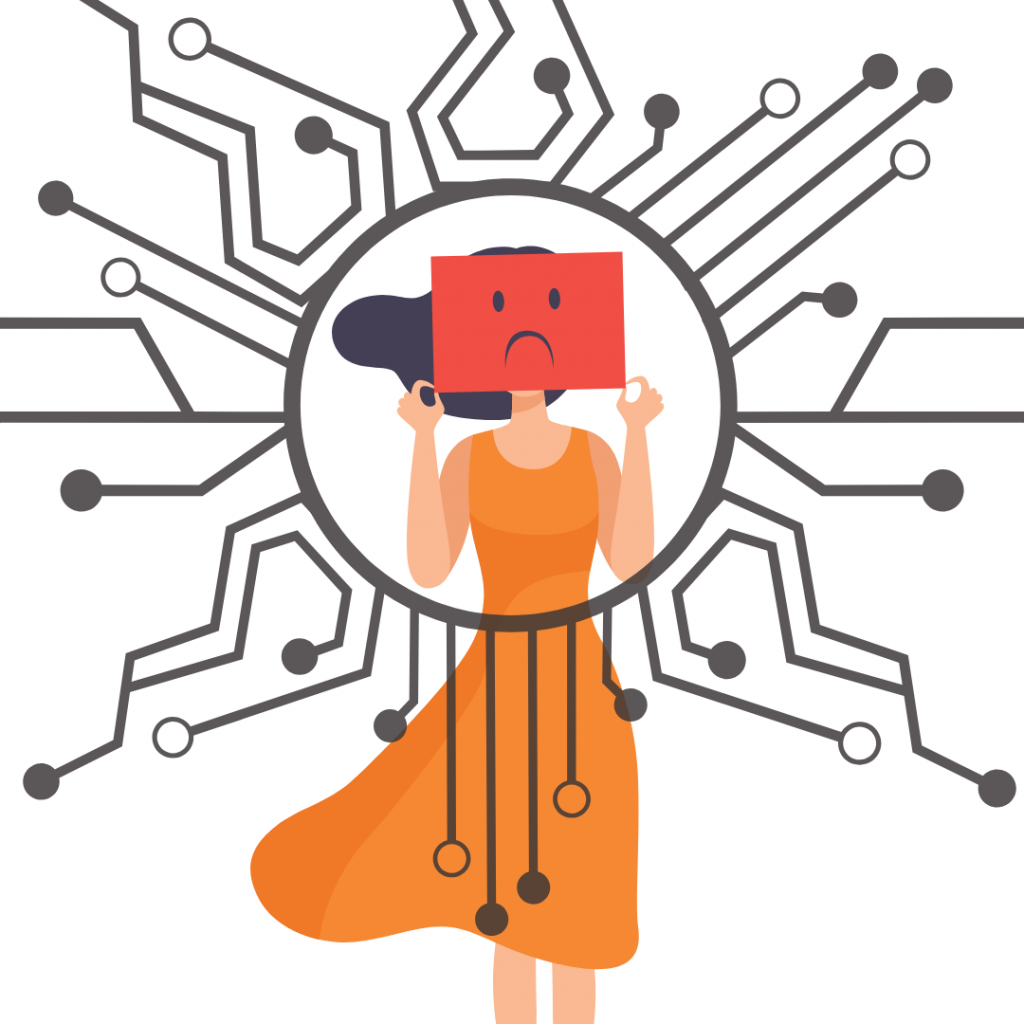
People may be willing to use a select handful of apps or tools, but it’s easy to become overloaded by all the choices out there. This overload kicks in earlier when the stakes are higher; for example, when our choices influence how we present ourselves to others and how others perceive us.
Add in factors of cost, redundancy, and specialization to the mix, and the choice becomes even harder to make. Evaluating all these options and features can be exhausting, resulting in people choosing not to choose at all [18].
Spoiled for Choice
The reality of decision fatigue is especially true for people trying to decide between similar paid technologies, like streaming services [19]. It’s one thing to have dozens of rarely-used apps on our phones. It’s another thing entirely to shell out money on a monthly basis (since most applications these days function on a subscription model).
Yet opting out of the decision-making process means we risk alienating our social connections, as we fail to meaningfully participate in the digital landscape.
If everyone in a social circle has a Netflix account and has been talking non-stop about Geralt’s moody vibes and how the stories compare to the game experience, anyone without this subscription will be left out of the conversation. It becomes a technological “keeping up with the Jones” balancing act. We can only afford (mentally and financially) to engage with certain platforms, but we must engage to feed our connections and perform our carefully cultivated identities.
The Solution?

The only way for a new technology to break through all that noise is to:
- solve as many problems as possible (seamlessly),
- have few to no barriers to access,
- offer plenty of strong security measures,
- feature a small learning curve, and
- enable integrations with everything else we’re already using.
Simple.
The reality is that as technology products and tools have developed from their humble roots, their base functions no longer impress us. When MySpace and Facebook were released, we marveled at the ease with which we could connect and talk with friends and family. We could even form new communities with people online and share the things we love (or love to hate).
Then we turned these platforms into opportunities to mold, curate, and present our identities to friends, families, communities… and prospectively the world.
The App Web
Now, we have a plethora of specialized social media apps that intersect and yet are distinct enough that it’s not enough to just have one.
We use Instagram to upload (and modify) pictures of our vacation, which we then share with Facebook to talk to a different set of communities. We switch to Twitter for our regularly scheduled doom-scrolling; maybe we’ll run across an interesting link to an AMA on Reddit that takes us to a series of YouTube videos. Our “Recently Watched” serves as fodder for reaction videos that we record and share on Snapchat or TikTok, to see how our friends (or followers) react. There might be time for a Zoom birthday party or baby shower, because it’s still Pandemic Times™ (and perhaps we’ve forgotten how to interact with people in person anyway.)
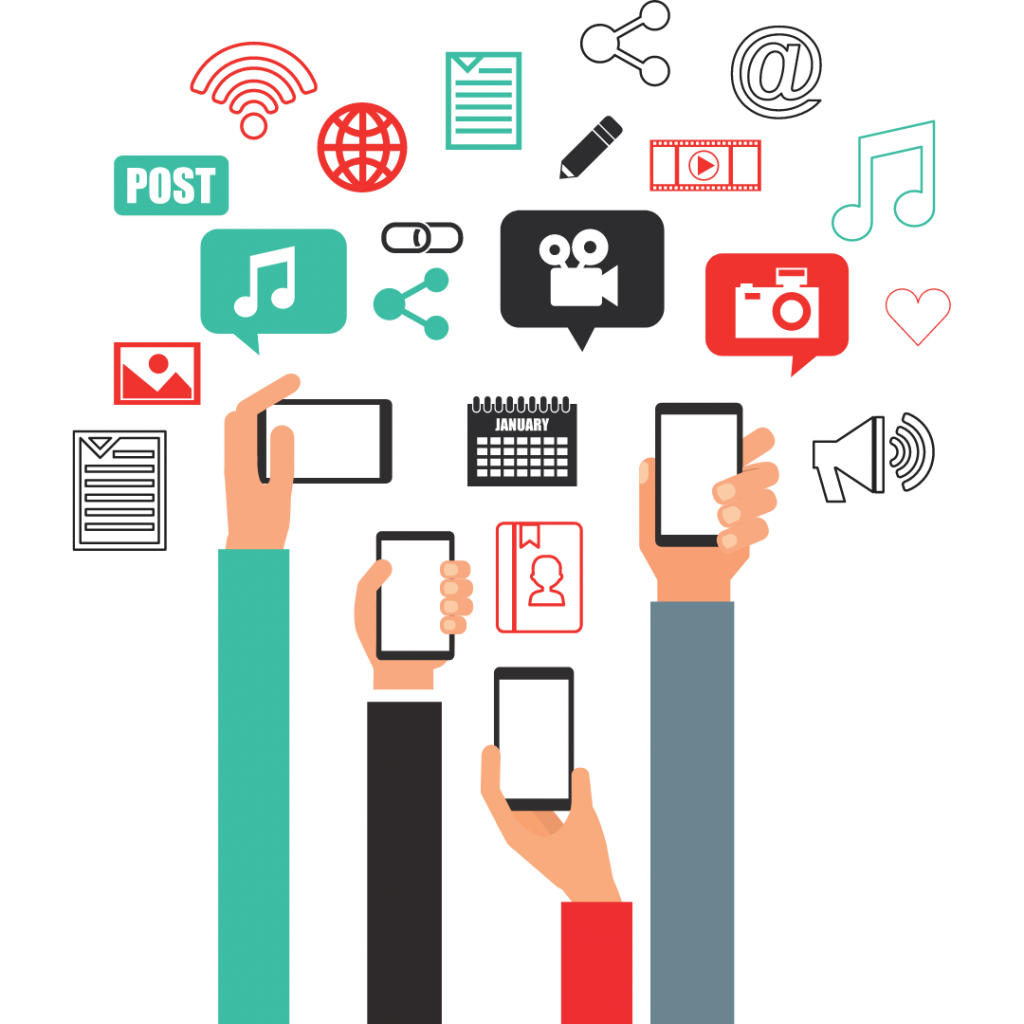
There are scads of apps for every purpose imaginable, all competing for attention and downloads. Professional environments have seen a similar boom, with productivity and collaboration tools trying to outbid and out-feature their competition to earn lucrative enterprise contracts. These commercial apps have learned from the social media giants, offering simple implementation and flexible integrations, which directly contribute to a blending of our personal and professional identities while online.
Simply responding to and mimicking existing technology isn’t enough to survive though. Technology and software tools can’t afford to mess up or slow down. Otherwise, they’ll lose our attention and become buried under the mass of notifications.
The Joy of AirSend
Naturally, we here at CodeLathe believe AirSend is a real solution for real people. It’s the ideal collaboration and communication platform for the modern identity, suitable for any project, personal or professional.
The weight of our decisions makes itself known when we become aware of how much time we lose switching between tasks. We go from our email to our calendar to a word document and realize it’s already been an hour with little to show for it.
The weight increases when we struggle to find a file we know exists, but the file explorer is convinced it does not. Or when we try to share said file (resurrected from the email archives) during a video conference, but the “share-screen” option isn’t working. Even though we’re not in person, we can feel everyone’s eyes boring into our soul as they all wait for the technical difficulties to be sorted. Politely though, because they’ve been there too.

This is not a unique scenario. Nor is it ideal. As our connections become ever-more digital, technological issues or dysfunctions are harder to tolerate, because they stymy our communication and distort our identities. The technology we use can become a barrier rather than a facilitator. There are plenty of options, certainly, in the tech- and app-saturated landscape. Yet few give us a truly holistic solution.
Where AirSend Shines
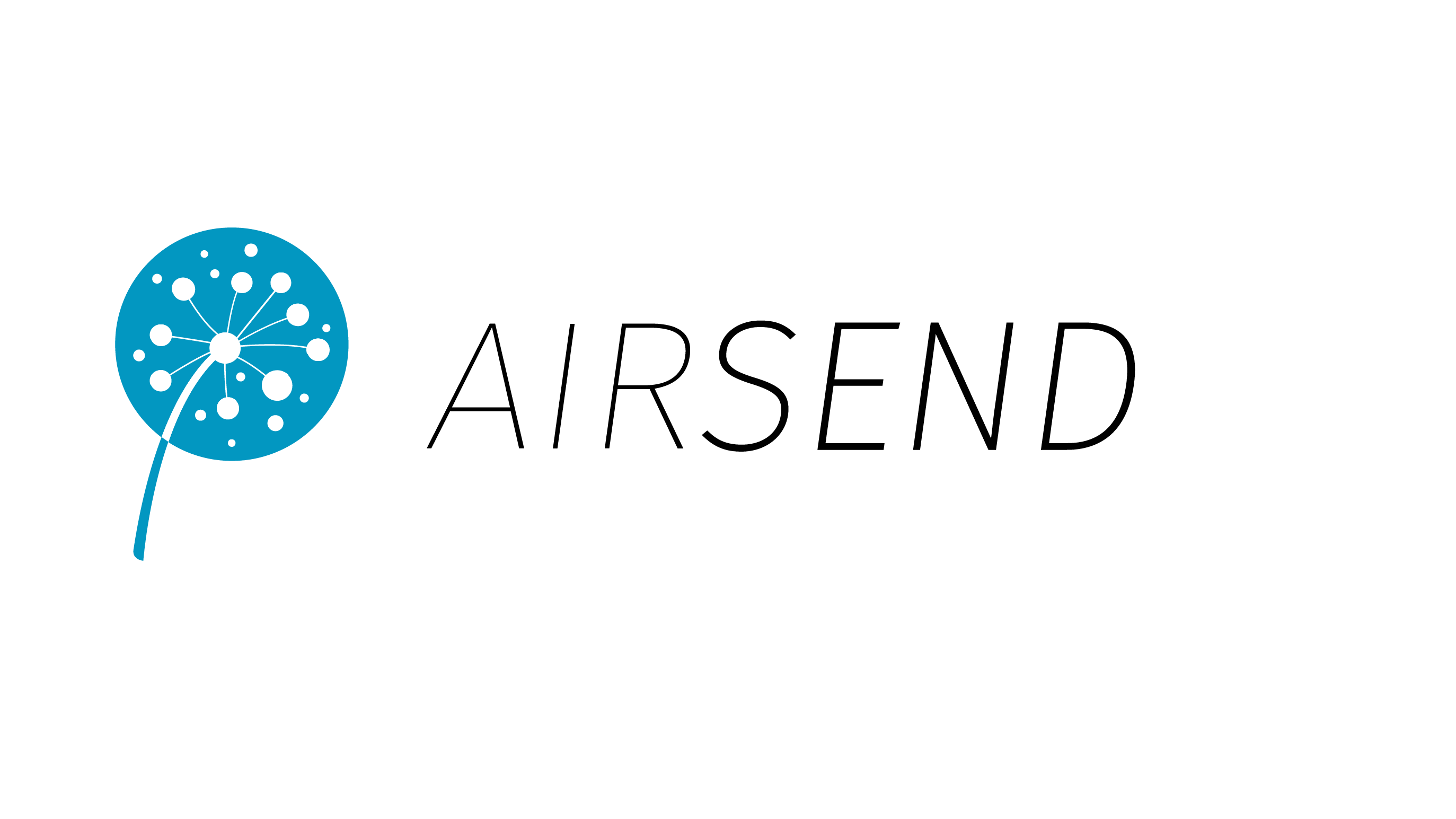
AirSend integrates all the features we’ve come to rely on throughout the pandemic and all the best aspects from social media, content sharing apps, and VoIP tools, organized into a free, easy-to-use (and easy to look at) platform. Here are just a few features represented by the deceptively simple dandelion icon:
- Security features and protected data (2FA, password-protected channels, encrypted file shares)
- Ease of access through integrations with Google Workspace and Microsoft-365 (more in the works)
- Responsive messaging platform between groups and individuals, with VoIP functionality
- Kanban-style board to manage actions, reminders, and goals
- Wiki section to store relevant information, files, and links
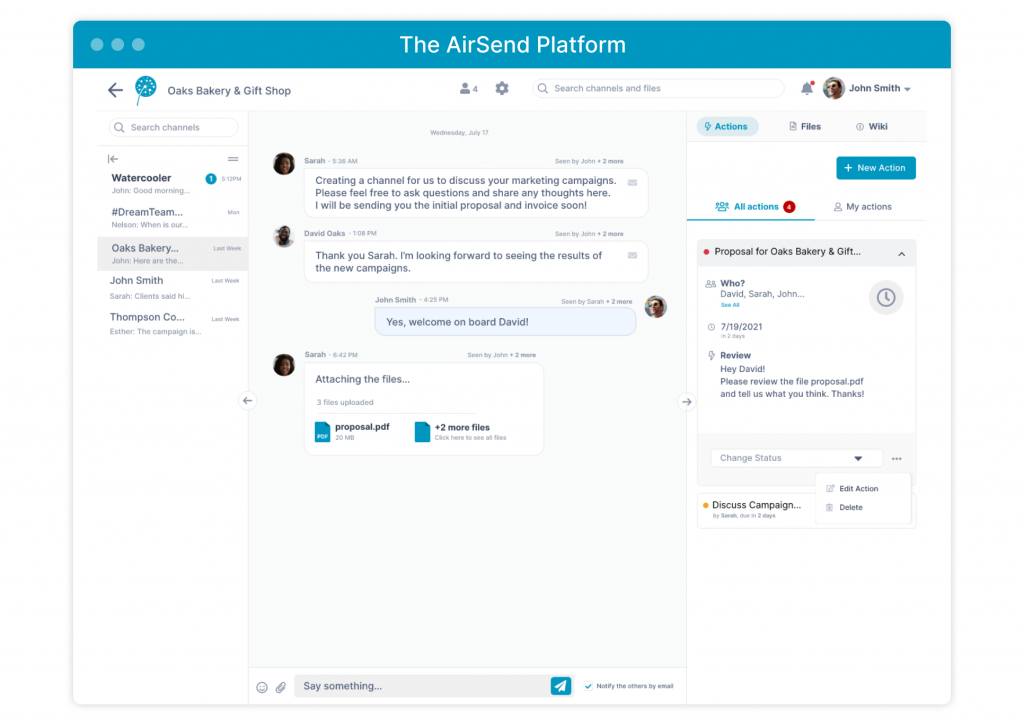
All-in-One Platform
The application is organized around the spirit of communication, which is the most important ingredient when it comes to collaboration. Open the account and the first screen is a view of all your channels, arranged in Kanban-style boards. By clicking on one of the channels, you can dive into some of the more sophisticated functions.
Within each channel, the main view enables users to easily send messages, links, or files to the channel recipients. You can also start or join a video call. Better yet, everyone can share their screen and use presentation tools, without the struggle of transferring host rights. You can even set up a channel for you alone, as a repository for information, reminders, and specific files.
The left sidebar provides a list of all your channels, which can be organized into groups. Select the options icon to add to a group or drag-and-drop for a more tactile experience.
The right sidebar includes tabs for Actions, Files and Links, and the Wiki. Saved reminders or tasks can be viewed under the Actions tab (with the option of adding due dates and assigning actions to team members). Shared files or links are found under Files and Links, auto-added when sent as a message in the channel. Last but not least, the Wiki fills a vital function as the channel’s unique library of reference material. As an added touch, you can format text and add separate pages or folders for better organization.
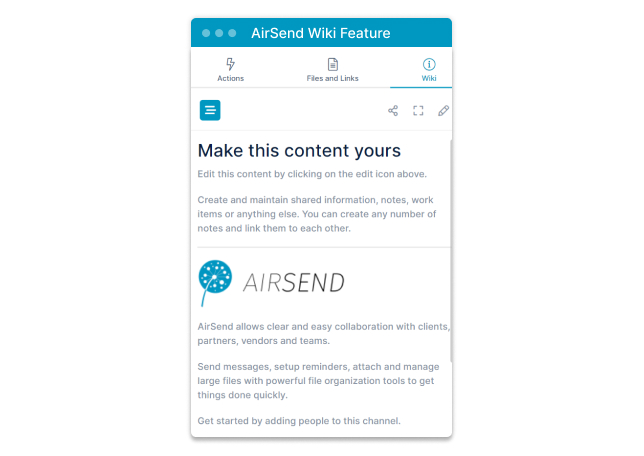
These channels are malleable and accessible, not just to peers within your network. Each channel has a unique email identifier, so anyone can send files and text to a channel. No account necessary. Channels can also be shared via link with external users, with the option of password-protecting it for extra security.
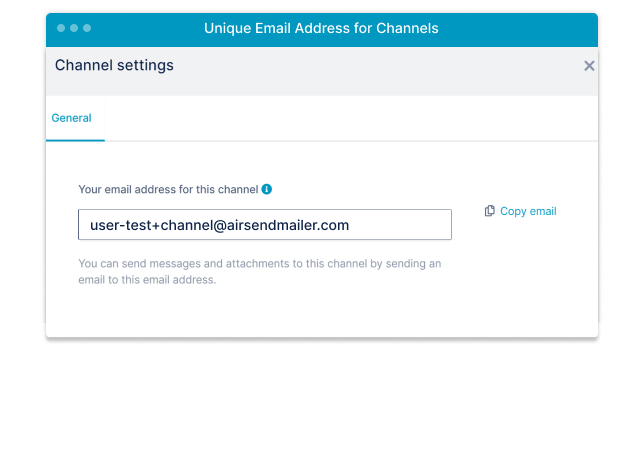
AirSend recognizes the value of your time and effort. For channels loaded with information that needs to be shared with new team members or external clients, AirSend offers the “Template” functionality. Channels can be duplicated for different sets of recipients while stripping out channel-specific messaging history. To protect and retain data, you can archive channels, and these channels can even be exported!
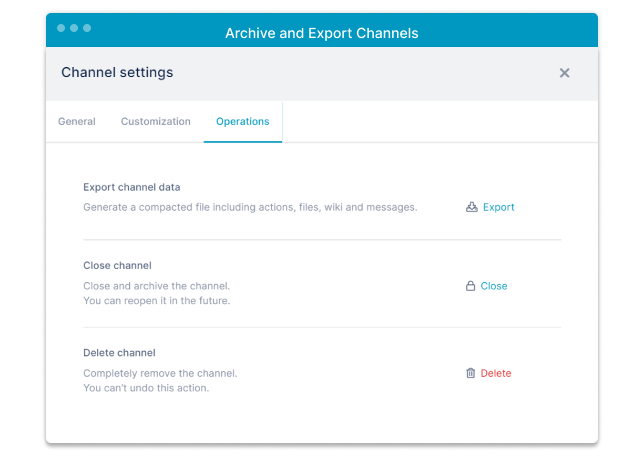
When you need to buckle down to accomplish major tasks or projects, it’s easy to swap the messaging platform for an expanded Kanban view of the Actions bar. This view enables drag-and-drop features for better sorting of actions and sub-actions.
Conclusion
Choosing the right technological tools and apps to balance your diverse needs and interests can have a major impact on your life. They influence not only how you present yourself to the world but also how you interact with your communities. Why waste time entertaining sub-par solutions?
AirSend offers the best of both worlds through simple and dynamic features. With a constant eye toward optimization, this tool only gets better with time. To sign-up for a free account and explore what AirSend can do for you, click here.
References
[1] McLeod, S. A., Abrams, D., Otten, S., & Hinkle, S. (2019, October 24). Social Identity Theory. Simply Psychology. https://www.simplypsychology.org/social-identity-theory.html
Hogg, M.A. (2004) The Social Identity Perspective: Intergroup Relations, Self-Conception, and Small Groups. Small Group Research 25, 246-276. DOI: 10.1177/1046496404263424
[2] Vanderbilt, T., (2013, June). Why you like what you like. Smithsonian Magazine. https://www.smithsonianmag.com/science-nature/why-you-like-what-you-like-73470150/
[3] Tankovska H. (2021, May). Online Dating in the United States. Statista.com. https://www.statista.com/topics/2158/online-dating/#:~:text=According%20to%20a%202019%20study,someone%20they%20had%20met%20online.
[4] Comrie, B. (2021). Language and Thought. Linguistic Society of America. https://www.linguisticsociety.org/resource/language-and-thought
[5] (2021, March). WIPO Report Finds Significant Growth in Assistive Technologies as They Find Greater Application in Consumer Goods. World Intellectual Property Organization. https://www.wipo.int/pressroom/en/articles/2021/article_0003.html#:~:text=2021-,WIPO%20Report%20Finds%20Significant%20Growth%20in%20Assistive%20Technologies%20as,Greater%20Application%20in%20Consumer%20Goods&text=According%20to%20the%20WIPO%20Technology,next%20decade%20as%20populations%20age.
[6] (2021, March). Assistive Technology Market to Grow by Nearly $8 Billion During 2021-2025. TechnavioCision PR Newswire. https://www.prnewswire.com/news-releases/assistive-technology-market-to-grow-by-nearly–8-billion-during-2021-2025–insights-on-covid-19-impact-analysis-key-drivers-trends-and-products-offered-by-major-vendors–technavio-301250800.html
[7] Miller, C.C. (2012, Oct). Google Wants to Join the Party, Not Crash It. New York Times. https://www.nytimes.com/2012/10/15/technology/google-devices-integrated-daily-lives.html
[8] Wong, R. (2018). Microsoft’s new game plan: Powering tech that’s way beyond PCs. Mashable.com. https://mashable.com/2018/05/09/microsoft-world-computer/
[9] Cupp, D. (2019, Dec). Microsoft’s Resolution for 2020 is to Empower Tech Intensity in its Customers and Partners. New.Microsoft.com. https://news.microsoft.com/transform/microsofts-resolution-for-2020-is-to-empower-tech-intensity-in-its-customers-and-partners/
[10] Cleo. (2019) Poor Integration Costs Businesses Half a Million Dollars Every Year, According to 2019 Market Report. Business Wire. https://www.businesswire.com/news/home/20190122005564/en/Poor-Integration-Costs-Businesses-Half-a-Million-Dollars-Every-Year-According-to-2019-Market-Report
[11] Forbes Technology Council. (2019, Oct). 16 Software Development Trends That Will Soon Dominate the Tech Industry. Forbes.com. https://www.forbes.com/sites/forbestechcouncil/2020/10/06/16-software-development-trends-that-will-soon-dominate-the-tech-industry/?sh=461b1b164aa3
[12] Wong, M. (2020, June). Stanford Research Provides a Snapshot of a New Working-From-Home Economy. Stanford News. https://news.stanford.edu/2020/06/29/snapshot-new-working-home-economy/
[13] Microsoft News Center. (2011). Microsoft News. https://news.microsoft.com/2011/05/10/microsoft-to-acquire-skype/#:~:text=%C3%A0%20r.l%20today%20announced%20that,of%20both%20Microsoft%20and%20Skype.
[14] Google. (2021). FAQ: Google Meet, Google Chat, and Hangouts. Support.Google.com. https://support.google.com/a/users/answer/9845199/faq-google-meet-google-chat-and-hangouts?hl=en
[15] Haider, A. & Rasay, S.J. (2020, June). Zoom’s Massive Growth Amid COVID-19 Set to Continue After Pandemic, Analysts Say. SPGlobal.com. https://www.spglobal.com/marketintelligence/en/news-insights/latest-news-headlines/zoom-s-massive-growth-amid-covid-19-set-to-continue-after-pandemic-analysts-say-58907516
[16] Richter, F. (2021, June). Zoom Keeps Momentum as Workers Stay at Home. Statista.com. https://www.statista.com/chart/21906/zoom-revenue/
[17] Sherman, N. (2020). Zoom Sees Sales Boom Amid Pandemic. BBC.com. https://www.bbc.com/news/business-52884782
Molla, R. (2020, Dec). The pandemic was great for Zoom. What happens when there’s a vaccine? Vox – Recode. https://www.vox.com/recode/21726260/zoom-microsoft-teams-video-conferencing-post-pandemic-coronavirus
[18] Why Do We Make Worse Decisions at the End of the Day? The Decision Lab. https://thedecisionlab.com/biases/decision-fatigue/
[19] Holland, L. (2021, Mar). The Price Is Not Right: Are There Too Many Streaming Services? The Guardian. https://www.theguardian.com/tv-and-radio/2021/mar/22/the-price-is-not-right-are-there-too-many-streaming-services